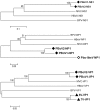Identification and nearly full-length genome characterization of novel porcine bocaviruses
- PMID: 21049037
- PMCID: PMC2963602
- DOI: 10.1371/journal.pone.0013583
Identification and nearly full-length genome characterization of novel porcine bocaviruses
Abstract
The genus bocavirus includes bovine parvovirus (BPV), minute virus of canines (MVC), and a group of human bocaviruses (HBoV1-4). Using sequence-independent single primer amplification (SISPA), a novel bocavirus group was discovered with high prevalence (12.59%) in piglet stool samples. Two nearly full-length genome sequences were obtained, which were approximately 5,100 nucleotides in length. Multiple alignments revealed that they share 28.7-56.8% DNA sequence identity with other members of Parvovirinae. Phylogenetic analyses indicated their closest neighbors were members of the genus bocavirus. The new viruses had a putative non-structural NP1 protein, which was unique to bocaviruses. They were provisionally named porcine bocavirus 1 and 2 (PBoV1, PBoV2). PBoV1 and PBoV2 shared 94.2% nucleotide identity in NS1 gene sequence, suggesting that they represented two different bocavirus species. Two additional samples (6V, 7V) were amplified for 2,407 bp and 2,434 bp products, respectively, including a partial NP1 gene and the complete VP1 gene; Phylogenetic analysis indicated that 6Vand 7V grouped with PBoV1 and PBoV2 in the genus of bocavirus, but were in the separate clusters. Like other parvoviruses, PBoV1, PBoV2, 6Vand 7V also contained a putative secretory phospholipase A(2) (sPLA(2)) motif in the VP1 unique region, with a conserved HDXXY motif in the catalytic center. The conserved motif YXGXF of the Ca(2+)-binding loop of sPLA2 identified in human bocavirus was also found in porcine bocavirus, which differs from the YXGXG motif carried by most other parvoviruses. The observation of PBoV and potentially other new bocavirus genus members may aid in molecular and functional characterization of the genus bocavirus.
Conflict of interest statement
Figures






References
Publication types
MeSH terms
Substances
LinkOut - more resources
Full Text Sources
Other Literature Sources
Miscellaneous

